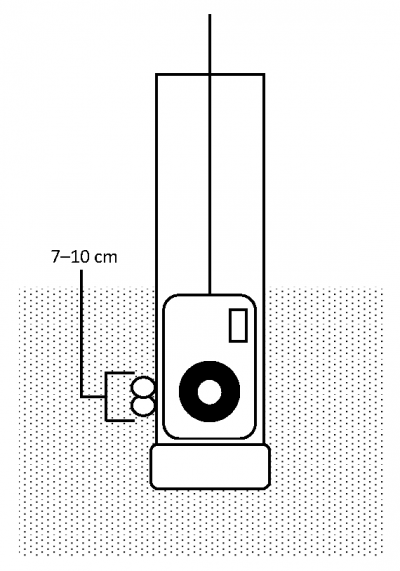Fire is landscape disturbance that can do great things for resident organisms. Certain plants and animals are adapted to cope with or even thrive in the earlier successional habitat created by this blistering disturbance. Serotinous pine cones that open following a fire, oak trees with thick bark protecting them from the heat of the fire, or grasses taking advantage of the nitrogen released in the post-fire soil. Small rodents like mice and chipmunks dive into burrows to protect themselves from the direct effects of a burn, only to re-emerge in a scorched world that will be filled with food, grasses and acorns, within a year. Other species like snakes and lizards may survive the fire and find a new forest with more sunlight reaching the forest floor and greater basking opportunities. Forestry managers have begun to reintroduce this natural disturbance back onto the landscape in the form of a controlled burn. And whereas some species may benefit from this disturbance, other species may not fare so well to the disturbance itself or the post-fire landscape. For many species, it is unclear how they will respond to prescribed fire.
- Post-fire landscape.
- The charred landscape may affect smaller trees, but the thick bark of Oak trees provide ample protection.
The effects of prescribed fire on vernal pools and vernal pool amphibians remains largely understudied. Some amphibian species like Spotted Salamanders, Jefferson Salamanders, and Wood Frogs rely on vernal pools as an essential habitat where their eggs can be deposited and larvae can develop in the presence of a plethora of food and absence of fishy predators. These pools disappear each summer only to refill with winter rain and snow melt, just in time for spring migrating salamanders and frogs which lay their eggs among their submerged branches and vegetation. The eggs and larvae of amphibians can be highly sensitive to changes in water chemistry and temperature. As fire changes the landscape around a vernal pool, it may also influence characteristics of a vernal pool. Reductions in forest canopy may allow more light to reach the vernal pool and increase amphibian larvae growth rates. Run-off from the burnt forest floor may also increase alkalinity within the vernal pool. Following a series of prescribed burns in Florida, Clay Noss and Betsie Rothermel found a slight increase in vernal pool water pH; however, this change did not affect their focal species, the Oak Toad. So, would a similar change be expected from prescribed fires in the forests of Pennsylvania? Would amphibians native to our vernal pools respond in similar ways to the Oak Toad?
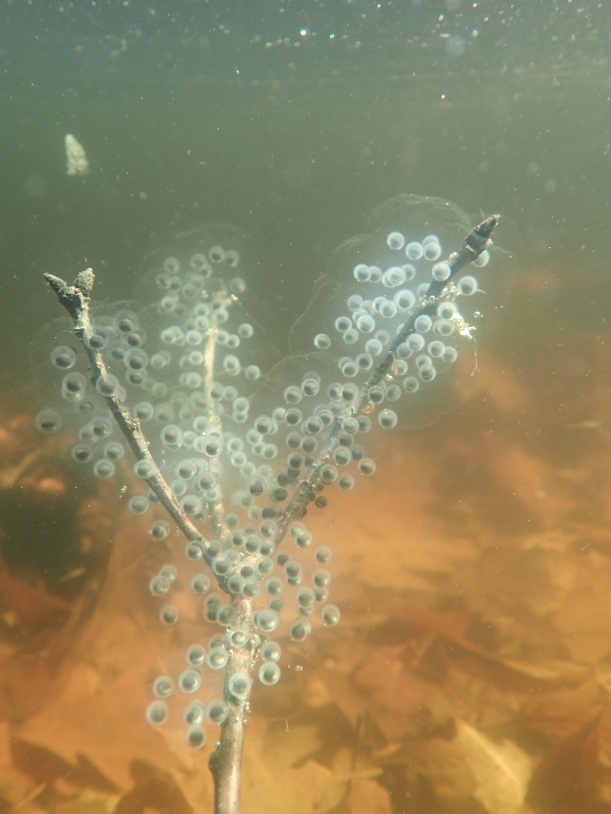
Jefferson Salamander eggs attached to a submerged branch.
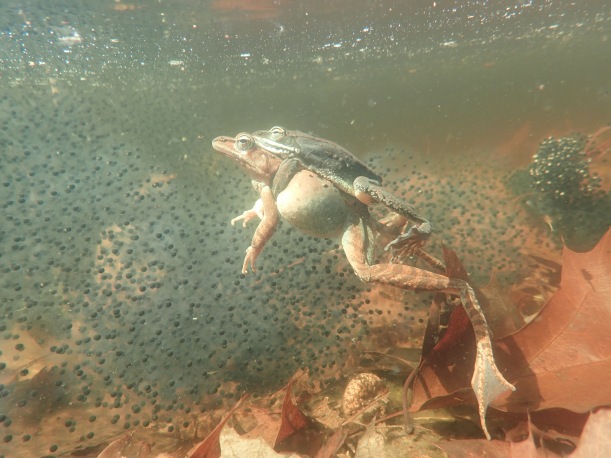
Wood Frogs mating within a vernal pool. Large swollen eggs are present in the background as well as a freshly laid egg mass to the right.
These are just a few of the questions that I am looking to answer with a couple research projects I began this spring. Luckily, I have the assistance of a fantastic undergraduate, Michaleia Mead, who will stay on after she graduates this spring and turn some of these projects into her Masters thesis. For our first project, we began sampling the water chemistry (pH, dissolved oxygen, conductivity), temperature, and physical characteristics of a series of vernal pools with differing burn histories. We are also measuring the canopy cover over the vernal pools and the amount of UV-B radiation that may reach the water surface. UV-B is known to cause detrimental effects on amphibians in high enough doses. We want to see if vernal pools in an oak dominated forest respond to prescribed fires in similar ways to the vernal pools of Florida. We will sample invertebrate and amphibian abundance and diversity within these vernal pools. Do we see a change in community composition of a vernal pool as characteristics are altered by prescribed fire?

Vernal pool located in a post-burn landscape. This tract of land was burned in 2014. Note the charred trees in the background and reduction in understory vegetation.
To accompany the field projects, we began to raise Wood Frog tadpoles in the lab under different pH and UV-B conditions. We will determine if these changes affect tadpole development and survival. Additionally, we will compare corticosterone levels among tadpoles from different treatments to determine if certain treatments lead to more stressed tadpoles. Even if tadpoles survive and develop under certain conditions, developing under stressful conditions can result in increased energy expenditures and decreased fitness. This could have implications beyond the vernal pool if recently metamorphed Wood Frogs have lower energy reserves.
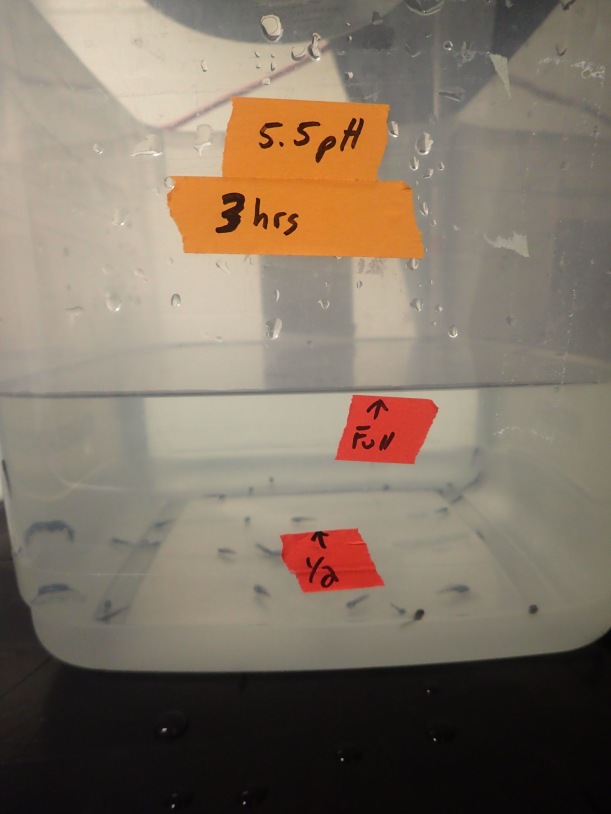
50 tadpoles are placed in each tank with varying amounts of pH and UV-B.
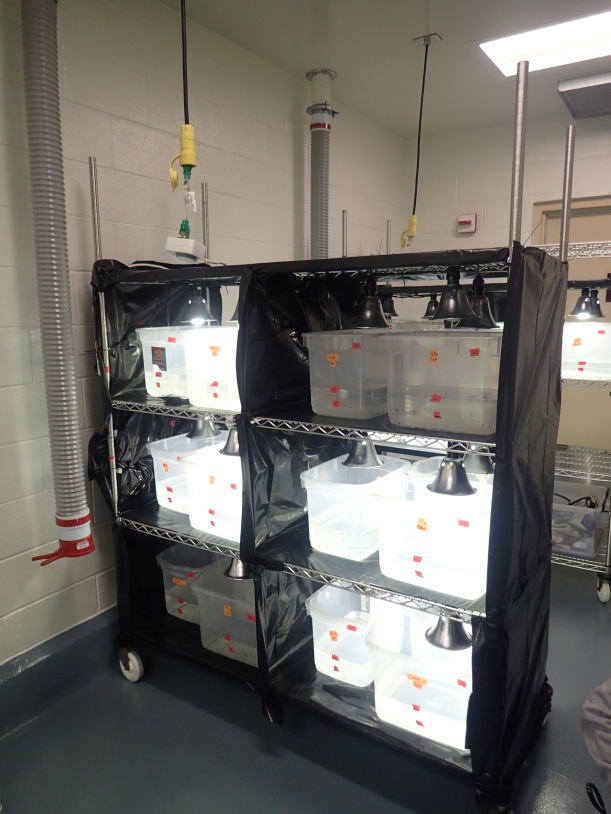
Our experimental set-up manipulates water pH and amount of UV-B exposure, while controlling room temperature.
So stay tuned as Michaleia and I update everyone on the progress of our studies!
- Me scouting out vernal pools in previously burned landscapes.
- Michaleia working hard in the lab as she cares for her tadpoles.






